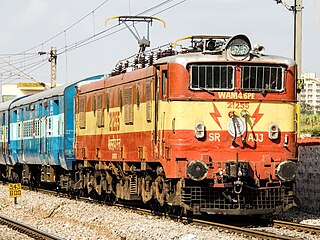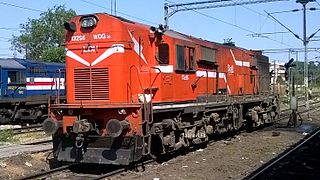
The American Locomotive Company was an American manufacturer that operated from 1901 to 1969, initially specializing in the production of locomotives but later diversifying and fabricating at various times diesel generators, automobiles, steel, tanks, munitions, oil-production equipment, as well as heat exchangers for nuclear power plants.
The Indian locomotive class WDM-2 is a class of diesel-electric locomotive that was developed in 1962 by American Locomotive Company (ALCO) for Indian Railways. The model name stands for broad gauge (W), Diesel (D), Mixed traffic (M) engine, 2nd generation (2). They entered service in 1962. A total of more than 2,700 WDM-2 was built at ALCO and Banaras Locomotive Works, Varanasi between 1962 and 1998, which made them the most numerous class of mainline diesel locomotive until its successor the WDM-3A.

The Indian locomotive class WAM-4 is a class of 25 kV AC electric locomotives that was developed in 1970 by Chittaranjan Locomotive Works for Indian Railways. The model name stands for broad gauge (W), alternating current (A), mixed traffic (M) locomotive, 4th generation (4). They entered service in March 1971. A total of 500 WAM-4 were built at CLW between 1970 and 1983, which made them the most numerous class of mainline electric locomotive till its successor the WAG-5.

The Indian locomotive class WDP-4 is a passenger-hauling diesel-electric locomotive with AC electric transmission designed by General Motors Electro-Motive Division and built by both GM-EMD and under license by Banaras Locomotive Works (BLW) of Varanasi, India for Indian Railways as the classes WDP4, WDP4B and WDP4D. The GT46PAC is a passenger version of the previous Indian Railways EMD GT46MAC freight locomotive. The locomotive has a 16-cylinder 710G3B diesel engine and is one of the fastest diesel-electric locomotives in service in Indian Railways.
The ALCO DL560C is a series of diesel-electric locomotive with AC electric transmission designed by the American Locomotive Company and produced under license by Banaras Locomotive Works (BLW) Varanasi, India for Indian Railways as their classes WDM-2, WDM-3A/2C, WDM-3D and WDG-3A for operation in India. The locomotive is fitted with a 16-cylinder ALCO 251 B,C diesel engine. In the early 1960s Indian Railways needed a reliable diesel workhorse to gradually replace its steam locomotive fleet. Equal numbers of ALCO's DL560C and EMD's G16 were chosen for trials. More locomotives of each of these were purchased for more trials. Indian Railways was keen on producing these locomotives in the country rather than depending on imports. EMD did not agree for a Transfer-of-Technology, while ALCO did. Thus ALCO DL560C was chosen for the job due to its easy maintenance, reliability and simple operation. And from then on vast numbers of this loco in different configurations have been produced and remain the main diesel traction power of Indian Railways.

The WDM-1 was the first class of Wide Gauge (W), Diesel powered (D), Mixed load (M), meant for hauling both freight and passenger trains. These are also the first mainline diesel engines imported after Independence. They were even the fastest diesel locomotives till the advent of WDM 2 and WDM 4. They used to haul ore/freight trains on SER. In the end, they were relegated to shunting/piloting duties or hauling sugarcane freight trains. One unit, #17000, is preserved at National Rail Museum, Delhi.

The Indian locomotive class WAP-1 is a class of 25 kV AC electric locomotives that was developed in 1980 by Chittaranjan Locomotive Works for Indian Railways. The model name stands for broad gauge (W), AC Current (A), Passenger traffic (P) locomotive, 1st generation (1). They entered service in late 1981. A total of 65 WAP-1 were built at CLW between 1980 and 1996, which made them the most numerous class of mainline electric passenger locomotive until its successor, the WAP-4.

The Indian locomotive class WDM-3D is a class of diesel-electric locomotive that was developed in 2003 by Banaras Locomotive Works (BLW), Varanasi for Indian Railways. The model name stands for broad gauge (W), Diesel (D), Mixed traffic (M) engine with 3300 horsepower (3D). The engine is classified WDM-3D though it outputs only 3300 hp and not 3400 hp as the name should suggest. They entered service in 2003. A total of 590+ WDM-3D were built at Banaras Locomotive Works (BLW), Varanasi between 2003 and 2016.

The Indian locomotive class WDP-3A, colloquially nicknamed the Toaster, is a class of diesel-electric locomotive that was developed in 1998 by Banaras Locomotive Works, Varanasi for Indian Railways. The model name stands for broad gauge (W), Diesel (D), Passengers traffic (P) locomotive with 3100 horsepower (3A). The WDP-3A is a later classification of earlier WDP-2. They entered service in 1998. A total of 44 were built between 1998 and 2001.

The WDM-7 is a diesel-electric locomotive of Indian Railways. It has been manufactured by Banaras Locomotive Works (BLW), Varanasi. The model name stands for broad gauge (W), diesel (D), mixed traffic (M) engine. Today, these are found exclusively at Chennai Central and nearby area.

The Indian locomotive class WDG-3A is a class of diesel-electric locomotive that was developed in 1994 by Banaras Locomotive Works (BLW),Varanasi for Indian Railways. The model name stands for broad-gauge (W), Diesel (D), Goods traffic (G) engine, 3,100 hp (3A) locomotive. They entered service on 18 July 1995. A total of 1,164 WDG-3A units were built between 1994 and 2015 at BLW, Varanasi with a few units being produced by Diesel Loco Modernisation Works (DLMW) and Parel Workshop.

The Indian locomotive class WCG-2 is a class of 1.5 kV DC electric locomotives that was developed in the late 1960s by Research Design and Standards Organisation (RDSO) and Chittaranjan Locomotive Works (CLW) for Indian Railways. The model name stands for broad gauge (W), DC Current (C), Goods traffic (G) engine, 2nd generation (2). They entered service in February 1971. A total of 57 WCG-2 were built at CLW between 1978 and 1983, which made them the most numerous class of DC electric locomotive.

The Indian locomotive class WDS-6 is a diesel-electric locomotive used by the Indian Railways mainly for shunting and also for performing departmental duties. The model name stands for broad gauge (W), Diesel (D), Shunting (S) engine, 6th generation (6). As of April 2022, 375 units of this class are currently in use all over India.
The Indian locomotive class WDM-3 is a type of diesel-hydraulic locomotive that was developed by Henschel for Indian Railways in 1962. The model name "WDM-3" stands for broad gauge (W), Diesel (D), Mixed traffic (M) engine, 3rd generation (3). These locomotives were put into service between 1970 and 1971, and a total of eight were built between 1962 and 1970. However, they were decommissioned at Gooty in 1995 and are now retired from service.

The Indian locomotive class YDM-5 is a class of diesel-electric locomotive that was developed in 1964 by General Motors (GM-EMD) for Indian Railways. The model name stands for Metre gauge (Y), Diesel (D), Mixed traffic (M) engine, 5th generation (5). They entered service in 1964. A total of 25 YDM-5 locomotives was built between 1963 and 1964.
The Indian locomotive class YDM-3 is a class of diesel-electric locomotive that was developed in 1964 by GM-EMD for Indian Railways. The model name stands for Metre gauge (Y), Diesel (D), Mixed traffic (M) engine, 3rd generation (3). They entered service in 1962. A total of 30 YDM-3 locomotives was built between 1961 and 1962.

Diesel Loco Shed, Tondiarpet is a motive power depot performing locomotive maintenance and repair facility for diesel locomotives of the Indian Railways. It is located near Tondiarpet railway station (TNP) of the Southern Railway zone in the city of Chennai, Tamil Nadu and is one of the four diesel loco sheds of the Southern Railway, the others being at Ernakulam (ERS) at Kochi, Erode (ED) and Golden Rock (GOC) at Trichy.
The WDM-2G is a class of diesel electric genset locomotive used in Indian Railways. It is one of the rarest locomotives in India with only two units being produced by Patiala Locomotive Works (PLW). The locomotives were produced with an intention of being fuel efficient and to be used for light to medium duties such as short passenger runs along with occasional shunting. They are one of the only two classes of locomotives in India to feature multiple prime movers, the other example being WDS-6G, which was designed solely for shunting. They have a rated power of 2,400 HP.
The Indian locomotive class WAP-3 was a class of 25 kV AC electric locomotives that was designed by Research Design and Standards Organization (RDSO) and Chittaranjan Locomotive Works (CLW) for Indian Railways in 1987. The model name stands for Broad gauge (W), AC Current (A), Passenger traffic (P) locomotive, 3rd generation (3). They entered service in 1988. They were the faster variant of the previous WAP-1 class. A total of 9 WAP-3 were converted from existing WAP-1 units at CLW between 1987 and 1988. All locomotives were now withdrawn from service and converted back to WAP-1.
The Indian locomotive class WDM-6 is a class of Diesel locomotive that was developed in 1981 by Banaras Locomotive Works (BLW), Varanasi for Indian Railways. The model name stands for broad gauge (W), Diesel (D), Mixed traffic (M) engine, 6th generation (6). They entered service in 1981. A total of 2 WDM-6 was built at between 1981 and 1982. They were decommissioned at Burdwan (BWN) in 2011.
















